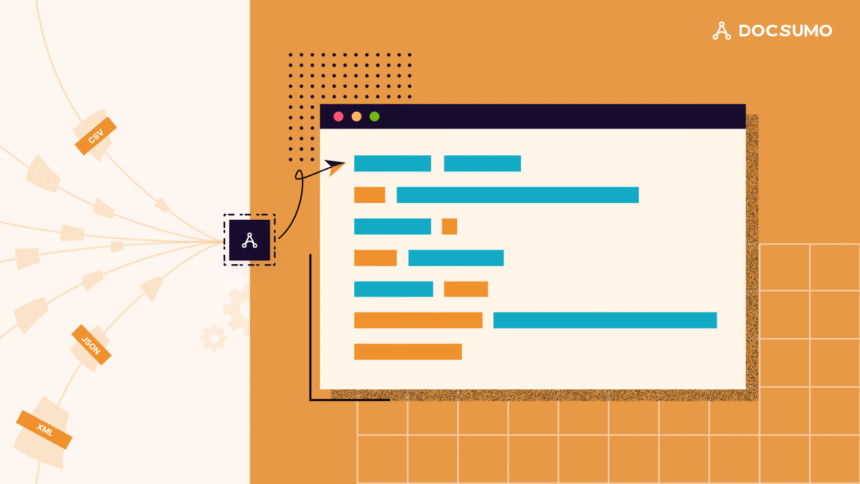Managing information efficiently is no longer a luxury—it’s a necessity. Organizations receive an overwhelming number of documents daily, ranging from invoices and purchase orders to contracts, receipts, and reports. Handling this deluge of information manually isn’t sustainable or scalable. That’s where document parsing tools come in.
Parsing tools use technologies like Optical Character Recognition (OCR), Natural Language Processing (NLP), and Machine Learning (ML) to automatically extract structured data from unstructured or semi-structured documents. These tools have become the backbone of modern document workflows, enabling automation, accuracy, and speed.
In this blog, we’ll explore how parsing tools power contemporary document processes, assess leading players in the market, why companies are evaluating Docparser alternatives, and how solutions like Docsumo are shaping the future.
What Are Document Parsing Tools?
A document parser is a software solution that automatically processes documents to extract meaningful data. These tools:
- Convert PDFs, images, scanned files, and emails into machine-readable formats
- Recognize and extract specific fields such as names, dates, invoice numbers, and totals
- Classify document types (e.g., invoices, contracts, forms)
- Integrate extracted data into ERP, CRM, or accounting systems
Parsing tools are essential for industries like finance, logistics, healthcare, insurance, legal, and government, where document volume and compliance needs are high.
Core Benefits of Parsing Tools in Document Workflows
Parsing tools play a critical role in modern document workflows by automating the extraction of structured data from a variety of document types. Below are some of the key benefits they offer across industries and use cases.
1. Efficiency and Speed
Automated data extraction reduces processing time by up to 80%. Documents that once took hours to process manually can now be parsed in seconds.
2. Improved Accuracy
Advanced parsing tools use AI models to detect and correct common human errors, resulting in higher data accuracy and fewer downstream issues.
3. Cost Reduction
By automating labor-intensive tasks, companies save on overhead costs, especially in accounts payable, legal, and operations.
4. Compliance and Auditability
Top parsing solutions offer secure audit trails and are compliant with standards like GDPR, HIPAA, and SOC 2.
5. Scalability
Whether you’re processing 500 or 50,000 documents a day, modern parsing tools can scale effortlessly with your business needs.
Popular Parsing Tools in the Market
1. Docparser
Docparser is one of the earliest players in document parsing and is known for its easy-to-configure parsing rules and cloud-based model. It works well for fixed-layout documents like invoices, purchase orders, and forms.
Strengths:
- User-friendly rule-based parser setup
- Integrates with Zapier, Google Sheets, and CRMs
- Good for repetitive, structured documents
Limitations:
- Not ideal for documents with varied layouts
- Limited AI/ML-based learning and adaptability
- Lacks domain-specific pre-built models
These limitations are driving businesses to explore docparser alternatives that offer greater flexibility and deeper automation.
2. Nanonets
A no-code AI platform that supports custom training on user-uploaded documents. It provides decent automation for standard business processes.
Pros:
- Easy to use and train
- Works across different industries
- Built-in human-in-the-loop review
Cons:
- May struggle with low-quality scans
- Custom logic setup can be restrictive for complex workflows
3. Rossum
Rossum is an AI-native data extraction platform built to process invoices and logistics documents without templates.
Pros:
- Intuitive interface
- Pre-trained invoice parsing models
- Good for AP automation
Cons:
- Limited flexibility for niche document types
- May require retraining for edge cases
4. Parseur
Parseur is an email parsing tool that focuses on extracting data from email content and attachments like PDFs.
Pros:
- Ideal for parsing emails at scale
- Visual templates for email layout detection
- Integrates with Zapier and Excel
Cons:
- Limited document types beyond emails
- Not optimized for regulatory workflows or handwritten documents
Why Enterprises Are Searching for Docparser Alternatives
Although Docparser remains a strong tool for parsing repetitive, template-based documents, it lacks the flexibility and intelligence that modern enterprises require. Businesses are exploring Docparser alternatives due to:
- Inability to handle documents with dynamic or non-standard layouts
- No built-in AI to adapt and learn from variations over time
- Lack of support for industry-specific use cases (e.g., logistics, insurance, finance)
- Limited enterprise integrations and auditability
According to a Gartner Market Guide for IDP, the demand for intelligent, adaptive document processing is driving a new wave of tools that prioritize usability, domain intelligence, and compliance.
What to Look For in a Modern Document Parsing Tool
When assessing parsing solutions, consider the following criteria:
- Template-Free Design: Tools should be able to handle document variation without constant rule updates.
- Custom Model Training: The platform should allow businesses to train models using their own documents.
- Built-in Validation: Ensure extracted data is accurate and flagged if outliers are detected.
- Security & Compliance: Look for certifications like SOC 2, GDPR, HIPAA, and support for data encryption.
- User Accessibility: Business teams should be able to configure workflows without technical expertise.
- Integration Ecosystem: Check compatibility with your existing software stack (e.g., ERP, CRM, storage).
Docsumo
Docsumo is quickly becoming a trusted name in intelligent document processing for mid-sized businesses and enterprises looking to automate complex workflows.
Why Choose Docsumo?
- AI-Driven Parsing: Handles dynamic and unstructured document layouts
- No-Code Rule Builder: Easily customize logic for different use cases
- Industry-Tuned Models: Pre-built support for finance, logistics, insurance, and KYC
- Real-Time Validation: Ensures accuracy with built-in human-in-the-loop support
- Enterprise-Ready: SOC 2, GDPR compliant, and integrates with top ERPs and CRMs
From freight invoices and bills of lading to insurance forms and vendor contracts, Docsumo offers the depth, speed, and intelligence needed for real-world document challenges.
Conclusion
Parsing tools are at the heart of modern document automation. They eliminate manual effort, reduce errors, and enable real-time decision-making across departments. While Docparser has long been a reliable option, its limitations have sparked a wave of innovation. Businesses are now seeking Docparser alternatives that offer AI-powered learning, deeper customization, and faster implementation.
Tools like Docsumo are leading this evolution—bridging the gap between smart automation and practical deployment. Whether you’re streamlining your accounts payable process, automating logistics documents, or improving compliance workflows, the right parsing solution can deliver a transformative impact.
The future of document management is intelligent, scalable, and fast—and it starts with the right parser.








